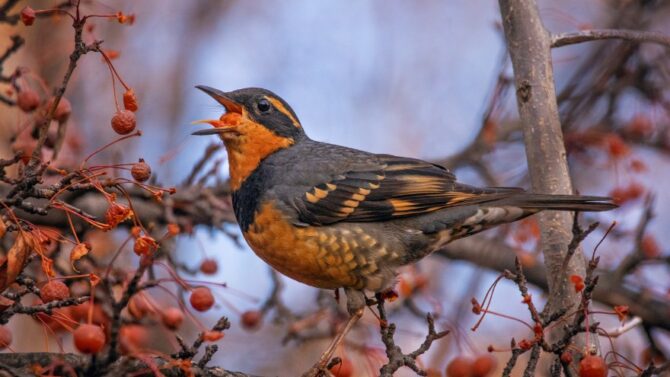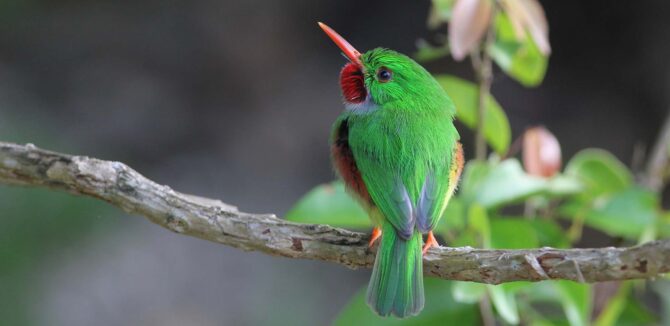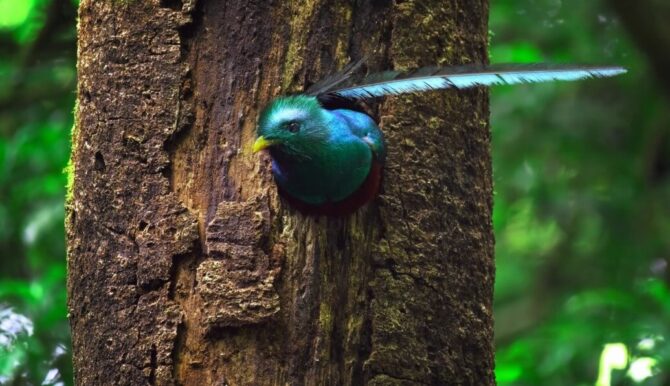Orioles are birds belonging to the genus Icterus of the blackbird family.
They are characterized by their beautiful black, yellow, and orange plumage, adorned with white markings.
However, not all birds with similar coloring are orioles.
There are several birds that look like orioles and are often mistaken for them due to their coloring. They include the eastern meadowlark, Blackburnian warbler, and American robin.
This article shares interesting details about these birds that share a striking resemblance and physical features with orioles.
12 Birds That Look Like Orioles
1. American Robin
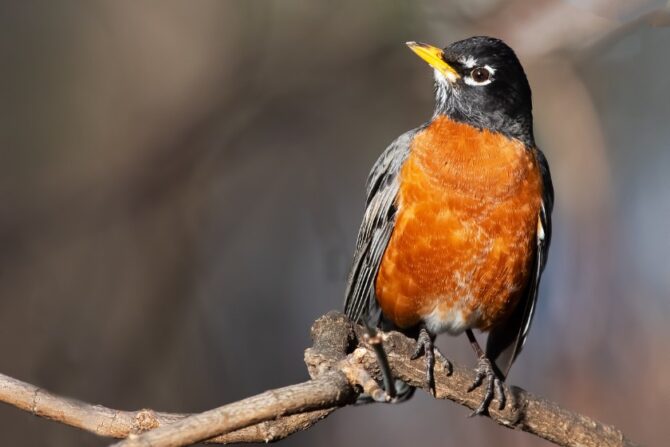
American robins are commonly seen across North America, especially in lawns, gardens, and backyards.
Like orioles, these birds have black heads, sharp claws, long tails, orange bellies, and black and white stripes on their wings.
Notably, female robins usually sport duller coloring than that of males.
While they prefer to dwell in towns, American robins can also thrive in wild environments, including dense forests.
They are more active during the day and usually gather in large flocks at night.
2. American Redstart
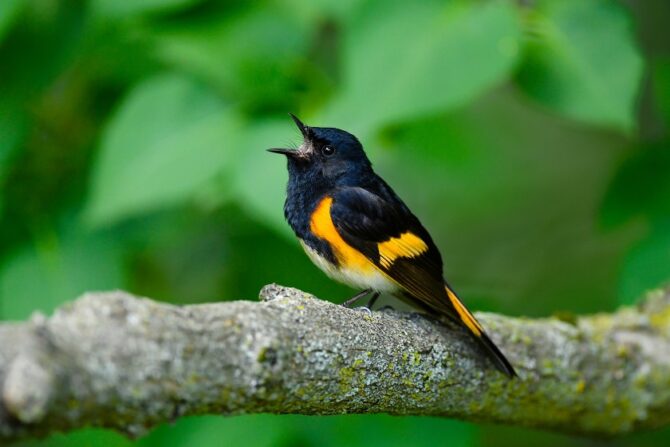
The American redstart’s vibrant colors can easily fool anyone into thinking it’s an oriole.
This bird features a beautiful combination of black and orange that resembles that of orioles.
Its back and wings are entirely black, and its underparts are adorned with orange patches.
Like orioles, it also sports thin legs and small, round eyes.
However, juvenile and adult female American redstarts show slight differences in their color.
Instead of black backs and wings, they sport an olive color, with yellow-orange patches and a dark-gray tail.
However, both males and females have white markings on their undersides.
One interesting fact about American redstarts is that they migrate over long distances.
While they are frequently seen in the eastern and northern United States, southern Canada, and parts of Alaska, they usually migrate as far as the Caribbean and Southern America during winter.
These fascinating birds inhabit moist, deciduous, second-growth woodlands.
3. Varied Thrush

The varied thrush is a music bird in the Pacific Northwest that fills the dense shrubs and moist conifer forests it inhabits with its melodious song.
Its yellow and orange color is the first noticeable similarity this bird shares with orioles.
Other features both birds share include a straight bill, round irises, and long legs.
However, varied thrushes have different color patterns. Their backs are bright orange and dark blue, while their breasts and bellies are burnt orange.
Their wings are black, featuring orange stripes.
Adult females share the same color pattern as males, although their plumage is browner, featuring patches of orange and burnt black.
These stocky birds are almost the size of the American robin.
They are also short-distance migratory birds, breeding in the western part of Alaska and traveling south toward the western part of the United States during winter.
4. Spotted Towhee
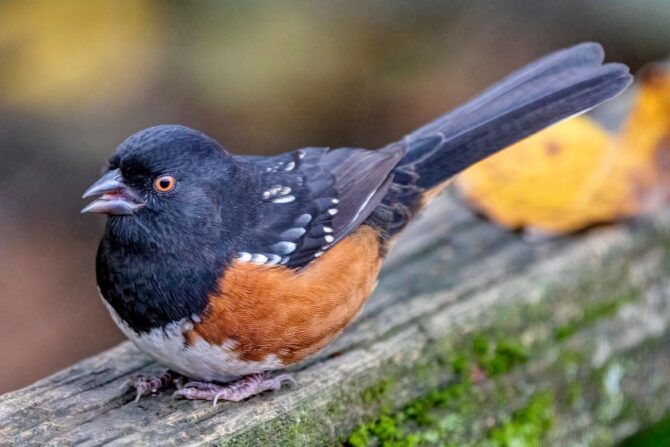
One significant behavioral difference between towhees and orioles is their preferred dwelling.
Towhees spend most of their time on the ground, foraging for food on the soil surface, while orioles prefer staying high up in treetops.
Despite this difference, these two birds share other interesting features.
For one, towhees have orange and black plumage and body structures almost identical to those of orioles.
However, these large sparrow birds have shorter bills and necks than orioles.
The spotted towhee also has a unique body pattern, with a jet-black upper body, orange sides, and a white underside.
They also have white spots on their back, wings, and belly.
These birds can be found in diverse habitats, including dry thickets, forest edges, and shrubby areas.
Their range extends across Alaska, Canada, the United States, and Mexico.
5. Evening Grosbeak
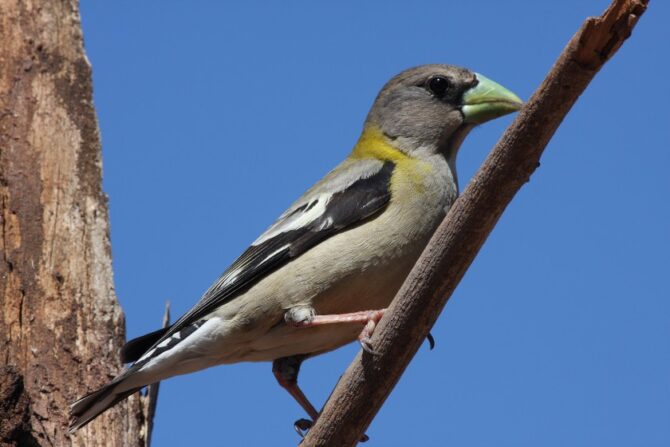
The evening grosbeak is popular as a songbird that doesn’t really sing,1 but that’s not the only thing that makes them so interesting.
These birds are also popular for resembling orioles, thanks to their black and yellow plumage with white spots on their wings.
Evening grosbeaks have a black head, grayish-brown neck and throat, and a yellow line above their eyes.
While adult females are similar to males, they stand out with gray bodies and a distinct green color on their necks.
Evening grosbeaks are commonly seen across the United States and live in coniferous forests and urban and suburban areas.
These birds can also be found in Alaska and Canada, highlighting their irregular migratory trait, as they travel based on the availability of food.
6. Blackburnian Warbler

One could be forgiven for mistaking the Blackburnian warbler for an oriole.
It has a dark top and light-colored bottom, much like an oriole.
It also features bright orange plumage, black feathers, a bright orange face and throat, and a white belly.
This small bird also has a thin, pointed bill, a medium-length tail, and relatively long, gray legs.
The Blackburnian warbler is a medium-distance migratory bird.
Hence, it breeds in eastern Canada and winters in South America.
It generally lives in mixed coniferous-deciduous forests.
7. Western Tanager
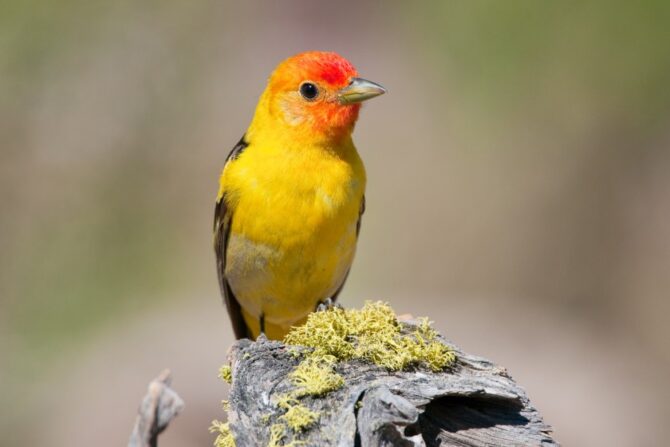
The western tanager is a bright yellow medium-sized songbird with short bills and medium-length tails.
Most parts of its body are yellow, although it sports an orange head and black wings and tail adorned with white bars.
Western tanagers share physical similarities to Scott’s orioles and Bullock’s orioles, which also feature yellow and black plumage.
Adult female western tanagers are similar to males, except for their grayish wings.
These birds usually breed in certain parts of Alaska and the western United States.
However, in winter, they migrate to southern Mexico.
8. Black-Headed Grosbeak
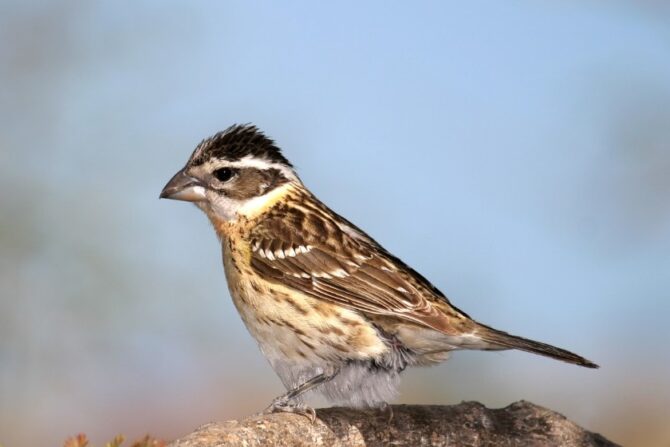
Black-headed grosbeaks and orioles are often mistaken for each other, as they have similar black upper body parts and orange underparts.
However, their distinctions easily stand out once they are observed closely.
For instance, orioles birds have pointy bills, while black-headed grosbeaks have large conical bills.
Black-headed grosbeaks also have large heads, short necks, robin-sized bodies, and short tails.
Like several birds resembling orioles, the black-headed grosbeak has orange and black plumage with an orange-cinnamon underside.
Females, however, are brown with a touch of orange on a white breast.
They are frequently spotted in deciduous and mixed wooded areas and berry-rich areas.
9. Eastern Meadowlark
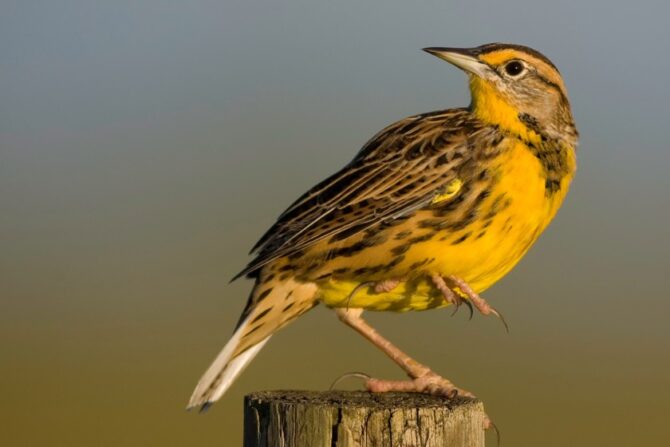
Eastern meadowlarks are characterized by spear-shaped bills, chunky, medium-sized bodies, rounded wings, and short tails, all dazzling in light yellow and brown plumage with black streaks.
While they lack traces of orange, these intriguing songbirds look much like adult female orioles.
Adult eastern meadowlarks have a prominent black V on their breast in their yellow underparts,2 along with white flanks and black streaks.
Eastern meadowlarks are short-distance migratory birds that breed in the eastern United States and southeastern Canada.
Their habitats include hay fields, grasslands, and pastures.
10. Western Meadowlark
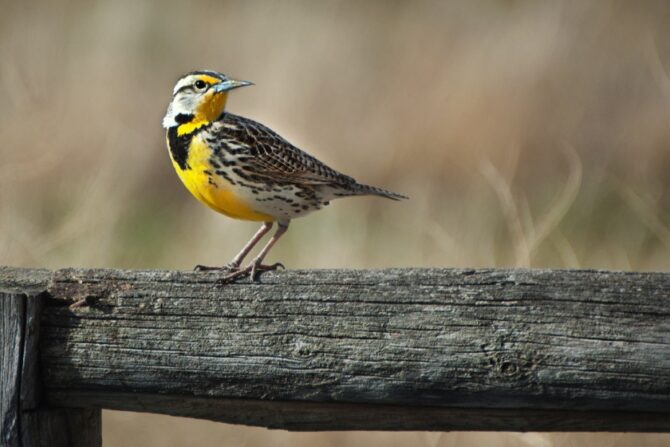
Western meadowlarks are closely related to eastern meadowlarks and thus bear a similar physical appearance to orioles.
Like eastern meadowlarks, they have yellow and brown plumage with a black V on their breast.
They also have long, pointed bills, and their upper body is covered in brown spots.
These birds inhabit low grassland, pastures, and abandoned fields across Western and Central North America.
11. Eastern Towhee
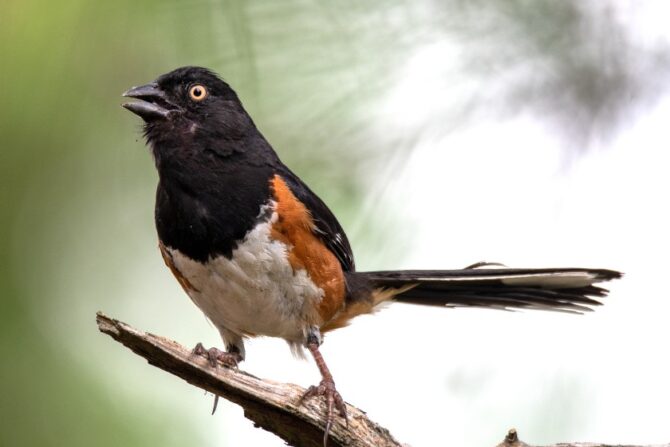
This large sparrow bird shares a similar body structure and color with orioles.
Closely related to the spotted towhee, the eastern towhee features a chunky body and large, thick triangular-shaped bill.
Its head, throat, wings, back, and tail are black.
It also has orange sides, a white belly, and little white markings on its wings.
While female eastern towhees feature the same color pattern as males, they have browner plumage.
Eastern towhees can be found in the eastern part of the United States and southeast Canada.
They usually inhabit overgrown woodlands, thickets, and shallow bushy shrub areas.
12. American Goldfinch
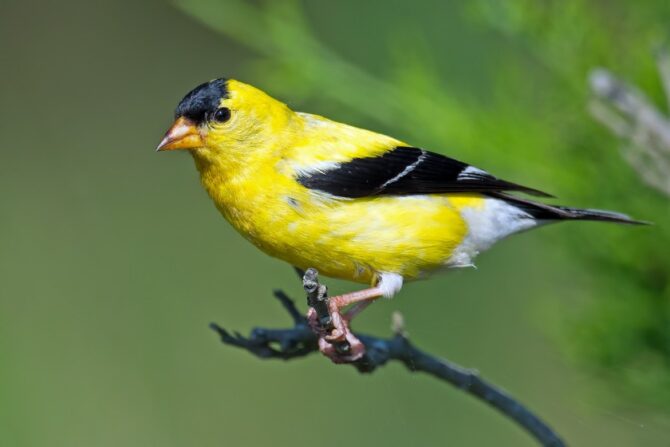
The American goldfinch is the only bird on this list that doesn’t stay true to its color yet still bears a physical resemblance to orioles.
This bird species is known for its molting cycle,3 sporting sparkling yellow plumage in summer and olive plumage in winter.
The American goldfinch features yellow and black plumage, like female orioles.
Adult male goldfinches have black wing feathers, while females sport brown ones.
Both sexes feature small, conical, pink bills which turn a vibrant orange during spring.
American goldfinches are migratory birds, with their range stretching from mid-Alberta to North Carolina during breeding season and from southern Canada to the United States border in winter.
They prefer living close to human settlements and are commonly seen in gardens, residential buildings, roadsides, and open meadow areas.
Frequently Asked Questions
How Many Types of Orioles Are There?
There are over 30 new world oriole species, including Scott’s orioles and Baltimore orioles.
How Do You Identify an Oriole?
Most orioles birds have a black upper body and a flame-orange lower body.
Are There Black Orioles?
Yes, there is a black oriole scientifically known as Oriolus hosii. It is endemic to the island of Borneo.
Which Is Bigger—An Oriole or a Robin?
Robins have an average length of 10 inches.
They have a round, stout body structure and are undoubtedly bigger than orioles.
Final Thoughts
There are several birds that look like orioles, and unless you’re a keen bird watcher, you might mistake one for another.
Even those in the field of science have been confused while trying to identify birds that share stunning resemblances.
For instance, the spotted towhee and eastern towhee were once considered as one species until further research proved otherwise.
Nature is fascinating in that certain animals resemble others, and orioles are not left out.
Hopefully, this article has enlightened you on the variety of birds identical to orioles.
References & Notes
- Evening Grosbeak. Montana Field Guide
- About Eastern Meadowlarks. Vermont Atlas of Life
- American Goldfinch Molt. Utah Birds
